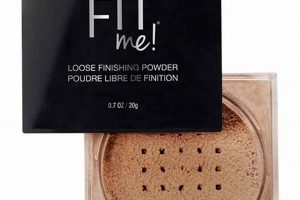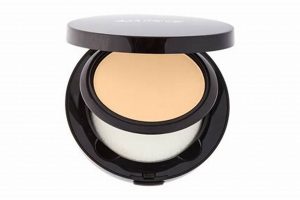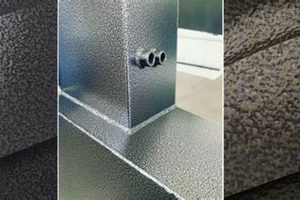This cosmetic product is a finely milled substance, typically white or colorless, designed for application as the final step in a makeup routine. Its primary function is to set foundation and concealer, minimizing shine and creating a smooth, even surface. For instance, after applying liquid foundation, a light dusting of this material across the face helps to prevent creasing and prolong the wear of the makeup.
Its importance lies in its ability to blur imperfections and create a soft-focus effect, enhancing the overall appearance of the skin. It achieves this without adding color or significant coverage, making it suitable for a wide range of skin tones. Historically, similar powders have been used for centuries to mattify the complexion, with modern formulations offering improved texture and performance.
The following sections will delve into the specific composition, application techniques, and selection criteria for this essential makeup item. This will include an examination of different types, appropriate tools, and considerations for various skin types and desired finishes.
Application and Usage Guidance
The following recommendations aim to optimize the use of this cosmetic to achieve a flawless and long-lasting makeup application.
Tip 1: Employ a Light Hand: Excess product can result in a cakey or unnatural appearance. Use a fluffy brush to lightly dust the face, focusing on areas prone to shine, such as the T-zone.
Tip 2: Utilize the “Baking” Technique with Caution: While effective for setting makeup, prolonged application of a thick layer can accentuate fine lines and wrinkles. Apply a moderate amount and allow it to sit for a short period before dusting off any excess.
Tip 3: Select the Appropriate Shade: Although often marketed as “translucent,” some variations possess subtle undertones. Conduct a patch test to ensure the product does not alter the underlying foundation color.
Tip 4: Consider Skin Type: Individuals with dry skin should opt for hydrating formulations to prevent a parched or flaky appearance. Those with oily skin may benefit from oil-absorbing variants.
Tip 5: Ensure Thorough Blending: Pay particular attention to areas where the product is applied most heavily to avoid visible lines or patches. A damp makeup sponge can aid in seamless blending.
Tip 6: Avoid Over-Application Under the Eyes: A thin layer is sufficient to set concealer. Excessive application can draw attention to fine lines and create a dry, crepey appearance.
Tip 7: Clean Brushes Regularly: Dirty brushes can transfer oils and bacteria, leading to breakouts and uneven application. Wash brushes frequently with a gentle cleanser.
Adhering to these guidelines can enhance the performance of this product, resulting in a polished and professional makeup finish.
The subsequent sections will provide a detailed analysis of different formulations and their suitability for various skin concerns.
1. Oil Control
The capacity to manage sebum production is a critical function of many cosmetic products, and this holds particularly true for the application of a specific finishing cosmetic. Its interaction with skin oils dictates the longevity and aesthetic appeal of the overall makeup application.
- Sebum Absorption
Formulations often contain ingredients like silica, rice powder, or modified starches specifically chosen for their ability to absorb excess oil from the skin’s surface. This absorption action prevents the formation of shine and maintains a matte finish. The quantity of oil absorbed influences the duration of the matte effect.
- Prevention of Makeup Breakdown
Excessive oil production can dissolve or break down foundation and concealer, leading to uneven coverage and a patchy appearance. By controlling oil, this cosmetic extends the wear time of underlying makeup layers, preserving the initial application’s intended look and integrity.
- Pore Minimization (Appearance)
While these products do not physically shrink pores, they can create a visual effect of reduced pore size. The matte finish reduces light reflection from the skin’s surface, diminishing the appearance of enlarged pores often accentuated by oily skin.
- Regulation of Surface Texture
Excess oil contributes to a greasy or slick texture on the skin. The application of a translucent finishing product designed for oil control improves surface texture, resulting in a smoother, more refined appearance and providing a better canvas for subsequent makeup touch-ups, if necessary.
The effectiveness of a given powder’s oil control capabilities is intrinsically linked to its composition and the specific needs of the individual’s skin. Strategic application is key to maximizing the benefits without causing dryness or a caked appearance. The success of this depends on carefully selecting a product that addresses the individual’s particular skin type and oil production levels.
2. Blurring Imperfections
The ability to diffuse light and minimize the appearance of skin irregularities is a central function when employing this specific cosmetic. Its capacity to create a more uniform surface is a key factor in achieving a flawless makeup finish.
- Optical Diffusion
Many formulations contain light-diffusing particles, such as silica or boron nitride. These particles scatter light as it hits the skin, reducing the visibility of fine lines, pores, and minor textural irregularities. The effect is akin to a soft-focus filter, creating a more even and smooth-looking complexion.
- Minimizing Pore Appearance
While it doesn’t physically alter pore size, the product fills in and smooths the edges of enlarged pores, making them less noticeable. The matte finish further reduces light reflection, which can accentuate pore visibility, contributing to a more refined skin texture.
- Softening Fine Lines and Wrinkles
The fine particles settle into fine lines, creating a smoother surface and reducing their prominence. The light-diffusing properties also help to obscure the shadows that can make wrinkles more apparent, resulting in a more youthful appearance.
- Reducing Redness and Discoloration
By creating a more uniform skin tone, it can help to minimize the appearance of minor redness or discoloration. The even base it provides allows for more effective concealer application, further camouflaging blemishes and uneven skin pigmentation.
The effectiveness in blurring imperfections is directly related to its particle size, light-diffusing capabilities, and its interaction with the underlying makeup. Proper application, using a light hand and appropriate blending techniques, is crucial for maximizing the blurring effect without creating a cakey or unnatural appearance. Strategic placement over areas of concern, such as around the eyes or on the forehead, can further enhance its imperfection-minimizing capabilities.
3. Setting Makeup
The process of setting makeup is integral to achieving longevity and preventing unwanted movement or creasing throughout the day. A specific finely milled cosmetic plays a crucial role in this process, acting as a final layer to secure and enhance the underlying products.
- Foundation Stabilization
Liquid and cream foundations, while providing coverage, possess inherent mobility. The application of a translucent powder creates a barrier that minimizes transfer, preventing the foundation from shifting due to facial movements, environmental factors, or contact with clothing. This stabilization is paramount in maintaining a consistent complexion.
- Crease Prevention
Creasing, particularly around the eyes and mouth, occurs when makeup settles into fine lines and wrinkles. Applying a light layer of powder sets the underlying concealer and foundation, preventing them from migrating into these areas and accentuating their appearance. The powder fills in minor imperfections, creating a smoother surface less prone to creasing.
- Oil Absorption and Shine Control
Sebum production can degrade makeup and cause unwanted shine. Powder formulations often contain absorbent ingredients that counteract oiliness, maintaining a matte finish and preventing makeup from dissolving or becoming patchy throughout the day. This aspect is particularly beneficial for individuals with oily or combination skin types.
- Enhanced Blendability
While seemingly counterintuitive, the application of a thin layer of powder can improve the blendability of subsequent products, such as blush or bronzer. The powder creates a slightly textured surface that allows these products to adhere evenly and diffuse more seamlessly into the underlying foundation, preventing harsh lines or uneven application.
These multifaceted contributions of a translucent setting substance underscore its significance in completing a makeup application. By stabilizing foundation, preventing creasing, controlling oil, and enhancing blendability, it serves as an essential component in achieving a polished and long-lasting appearance, ensuring that the initial application remains intact for an extended period.
4. Texture Refinement
The attainment of a smooth and even skin surface is a primary objective in cosmetic application. In this context, the utilization of a specific translucent product serves a crucial function in refining skin texture and minimizing the appearance of irregularities.
- Pore Minimization (Visual Effect)
The filling of enlarged pores and the creation of a light-diffusing effect contribute to a smoother surface. The translucent particles settle into the contours of the pores, reducing their apparent size and creating a more uniform skin texture. Examples include application on the T-zone, where pores are often more prominent. This effect is a visual refinement, not a physiological alteration.
- Reduction of Fine Lines and Wrinkles (Appearance)
Settling into fine lines and wrinkles serves to soften their appearance. The light-scattering properties diminish the shadows that accentuate these lines, resulting in a smoother and more youthful-looking complexion. Careful application is essential to prevent the accumulation of product, which can paradoxically emphasize these features.
- Smoothing of Uneven Skin Texture
Minor surface imperfections, such as slight bumps or scars, can be visually minimized. The translucent particles create a more uniform plane, thereby reducing the appearance of surface irregularities and contributing to a more refined overall skin texture. Strategic application over areas with uneven texture can yield a more polished appearance.
- Velvet or Matte Finish Creation
Altering the way light reflects from the skin impacts its perceived texture. The product creates a matte or velvet finish that reduces shine and provides a more uniform appearance, often perceived as refined. This effect is achieved through ingredients that absorb excess oil and scatter light evenly across the skin surface.
The collective effects underscore the significance of the product in attaining a visually refined skin texture. By strategically utilizing the light-diffusing and oil-absorbing properties, a more uniform and polished complexion can be achieved. Individual results, however, will vary depending on skin type, application technique, and product formulation.
5. Shine Reduction
Excessive shine on the skin, often caused by sebum production, detracts from a polished makeup application. A specific type of finely milled cosmetic serves a key function in mitigating this issue, promoting a matte or satin finish.
- Sebum Absorption Mechanisms
Formulations commonly incorporate absorbent materials such as silica, modified starches, or clay derivatives. These ingredients actively bind to excess oil on the skins surface, diminishing the reflective quality that contributes to unwanted shine. The absorption capacity varies depending on the specific ingredient and its concentration within the formulation, affecting the duration of the matte effect.
- Light Diffusion and Matte Finish
Beyond direct oil absorption, certain powders employ light-diffusing particles. These particles scatter light away from the skin’s surface, creating a soft-focus effect and further reducing the appearance of shine. This mechanism contributes to a more even and less reflective complexion, often described as a matte or velvet finish. The degree of light diffusion influences the intensity of the matte effect.
- Formulation Impact on Oil Control
The overall formulation influences the efficacy of shine reduction. Binding agents, such as silicones, create a barrier that inhibits oil from migrating to the surface. Powders lacking such ingredients may provide initial shine control but offer less prolonged effectiveness. Individuals with particularly oily skin may benefit from formulas specifically designed for extended oil control.
- Application Techniques for Optimal Results
Even with an effective formulation, appropriate application is crucial. A light dusting with a fluffy brush is generally recommended to avoid over-application and a cakey appearance. Focusing application on areas prone to shine, such as the T-zone (forehead, nose, and chin), maximizes the shine-reducing benefits. Blotting with tissue paper prior to application can further enhance the powder’s effectiveness.
The interplay of oil absorption, light diffusion, formulation composition, and application technique dictates the degree of shine reduction achieved with a particular translucent finishing product. Selection should be tailored to individual skin type and desired finish, with consideration given to the longevity of the shine-reducing effects.
Frequently Asked Questions about translucent finishing powder
The following addresses common inquiries concerning the nature, usage, and selection of translucent finishing powder. The information provided aims to clarify misconceptions and enhance understanding of this cosmetic product.
Question 1: Is translucent finishing powder suitable for all skin tones?
Generally, yes. Its lack of pigment is designed to prevent alteration of the underlying foundation shade. However, some formulations may contain subtle undertones that could potentially affect the appearance of very fair or very deep skin tones. A patch test is recommended prior to full application.
Question 2: How does translucent finishing powder differ from setting powder?
While the terms are sometimes used interchangeably, a dedicated setting powder may contain ingredients specifically designed for oil absorption and longer wear. Translucent options primarily focus on creating a smooth finish and minimizing shine without adding significant coverage.
Question 3: Can translucent finishing powder be used without foundation?
Yes. It can be applied directly to the skin to minimize shine, blur imperfections, and create a more even complexion. However, the effect will be less pronounced compared to application over foundation.
Question 4: Does translucent finishing powder cause flashback in photography?
Certain formulations, particularly those containing a high concentration of silica, may cause a white cast in flash photography. Selecting a product specifically formulated to minimize flashback is recommended, especially for events where flash photography is anticipated.
Question 5: How often should translucent finishing powder be reapplied?
Reapplication frequency depends on skin type and environmental conditions. Individuals with oily skin may require touch-ups throughout the day. Those with drier skin types may find a single application sufficient. Monitor shine levels and adjust accordingly.
Question 6: What is the best method for applying translucent finishing powder?
A large, fluffy brush is generally recommended for even application. A damp makeup sponge can be used for targeted application or to “bake” the powder, allowing it to sit on the skin for a period before dusting off excess.
In summary, a nuanced understanding of the various formulations and application techniques associated with translucent finishing powder allows for optimal utilization and achievement of desired aesthetic outcomes. Proper selection and application are crucial for maximizing the benefits of this product.
The following section provides detailed guidance on selecting the most appropriate type of translucent finishing powder for specific skin concerns.
Conclusion
The preceding exploration of translucent finishing powder has elucidated its multi-faceted role in cosmetic application. From its capacity to control shine and blur imperfections to its function in setting makeup and refining skin texture, this product demonstrably contributes to a polished and long-lasting makeup finish. The distinctions between various formulations and the impact of application techniques have been underscored, emphasizing the need for informed selection and strategic utilization.
The continued evolution of cosmetic technology suggests ongoing refinements in translucent finishing powder formulations, potentially offering enhanced performance and addressing specific skin concerns with greater precision. Further research into individual ingredient interactions and the long-term effects of daily use remains a significant area of inquiry. Continued critical assessment of product claims and informed application practices will ensure that the benefits of translucent finishing powder are maximized, while potential drawbacks are minimized.







